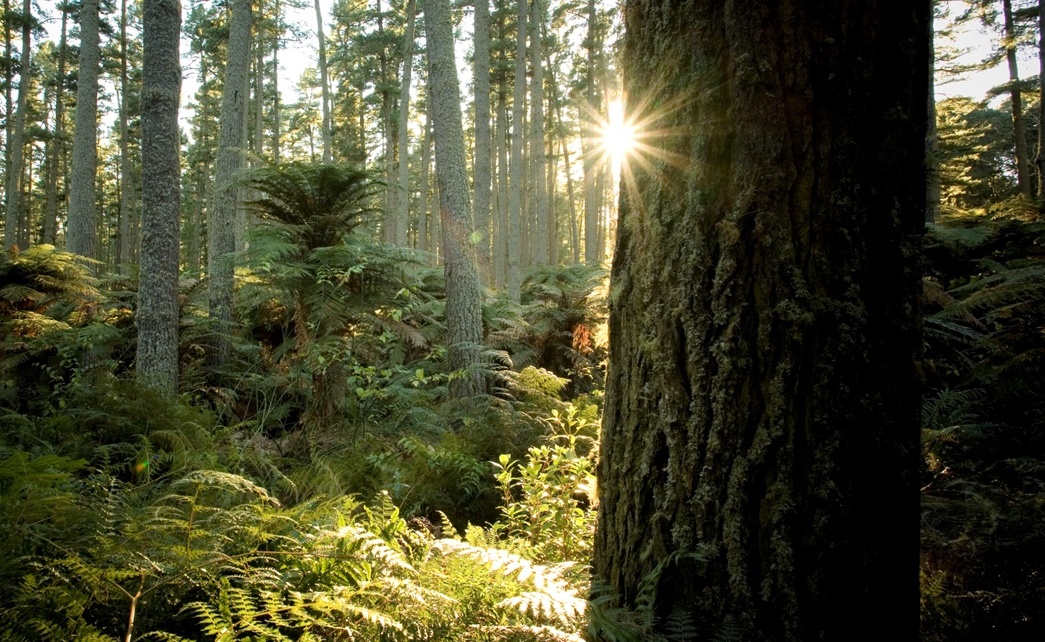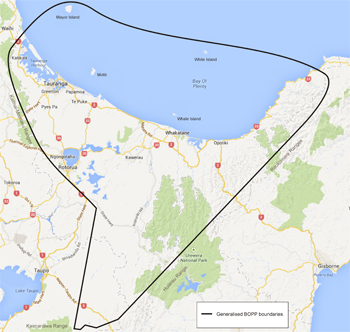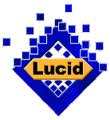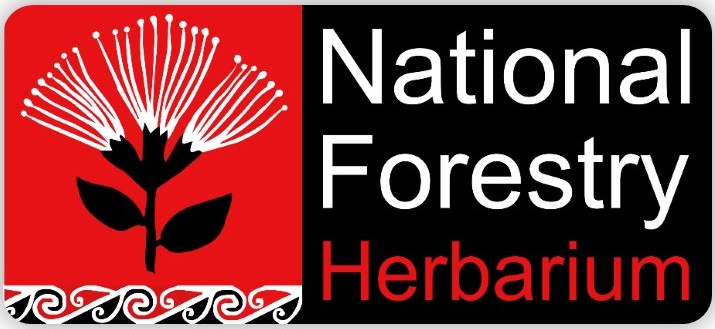


The National Forestry Herbarium and Xylarium (NZFRI) specialise in cultivated tree species associated with forestry and amenity planting, and includes extensive collections of eucalyptus and pine species. It also contains a wide range of New Zealand native and naturalised plants, and is the regional herbarium for the Bay of Plenty, East Cape and central North Island of New Zealand.
Founded in 1945, the collection focus has been on plants significant to plantation and indigenous forests in New Zealand. The herbarium is increasing its specimens of woody trees and shrubs in New Zealand as part of its emphasis to respond to Biosecurity threats in indigenous, plantation and urban forest environments.
Eucalypts and conifers together comprise approximately 23% of the herbarium collection. Pines make up ca. 30% of the Gymnosperms. There is a good coverage of cultivated species of eucalypts, with more than 2800 specimens, representing ca. 360 species. Other plantation tree species are well represented and there are specimens of forest trees from Australia, Fiji, Samoa, Vanuatu and Mexico, amongst others.

 Assistant Curator: Elizabeth Miller
Assistant Curator: Elizabeth Miller

 Herbarium technician: Wendy Hurren
Herbarium technician: Wendy Hurren
Loans
The National Forestry Herbarium participates in a loan programme with herbaria listed
in Index Herbariorum.
Specimens are loaned for the purpose of taxonomic research. Those wishing to loan
specimens from the National Forestry Herbarium must abide by the herbarium's loan
conditions. Researchers are encouraged to make use of our online loan system.
Visitors
The National Forestry Herbarium is a PC 1 Containment Facility and therefore not
open to the public. Access for bona fide researchers or for educational purposes is by prior arrangement with the curator only.
Hours
9am to 4:30pm Monday-Friday, closed on public holidays.
The National Forestry Herbarium provides a range of information services to the forestry community, researchers and the public. These services include:
Plant identifications
The better the samples we receive, the better we can identify a plant. Good
samples usually imply fertile material (i.e. more than just branches and leaves) possessing reproductive parts like cones or
flowers and fruits/capsules. If you wish to have a tree identified, it is recommended that you provide us with material that contains:



Eucalypts and Pines can be particularly challenging to identify and the following set of characters will assist greatly:
| Pines | Eucalypts |
|---|---|
|
|



Plant identifications cost $65 (includng GST) per specimen. Send plant material sealed in a bag with
your contact details either via mail to:
Herbarium Curator, National Forestry
Herbarium, Scion, Private Bag 3020, Rotorua 3046, New Zealand
or
via courier to:
Herbarium Curator, National Forestry Herbarium, Scion, 49 Sala
Street, Rotorua, New Zealand
The National
Forestry Herbarium, situated in the heartland of the Bay of
Plenty (BOP) region, also fulfils a role in servicing public
agencies, private companies and individuals in terms of
documenting and identifying the regional flora. The National
Forestry Herbarium has embarked upon a project entitled "Bay
of Plenty Plants (BoPP)" with the ultimate aim of compiling a
conspectus for the region.
 For the purposes of BoPP, we follow Beadel et al. (2010) and
define the Bay of Plenty based on the boundaries of 16
Ecological Districts (ED), namely: Te Aroha, Mayor Island, Motiti,
Tauranga, Otanewainuku, Rotorua Lakes, White Island, Te Teko,
Taneatua, Opotiki, Kaingaroa, Whirinaki, Ikawhenua, Waimana,
Waioeka and Motu.
For the purposes of BoPP, we follow Beadel et al. (2010) and
define the Bay of Plenty based on the boundaries of 16
Ecological Districts (ED), namely: Te Aroha, Mayor Island, Motiti,
Tauranga, Otanewainuku, Rotorua Lakes, White Island, Te Teko,
Taneatua, Opotiki, Kaingaroa, Whirinaki, Ikawhenua, Waimana,
Waioeka and Motu.
Essentially, the BOP borders take on the form of an inverted triangle. The region stretches from the southern reaches of the Coromandel Peninsula in the North West to Cape Runaway in the North East and is home to about 260 km of open coastline and incorporates several large islands. Flanked by the Kaimai-Mamaku ranges to the west, and the Raukumara and Huiarau Ranges to the east, the BOP region extends some 140 km south towards the interior as far as the Kaimanawa Range.
Checklists are by their nature out-dated as soon as they have been printed, whereas online checklist incorporate nomenclatural and taxonomic changes as soon as they have been entered into a database. Consult the NZFRI database and filter for BOP in the LOCALITY field for the latest version of the checklist. Ecological Districts are currently recorded in the HABITAT field.
 As pointed
out by Buys (2012), although plant lists have been a popular
way of documenting the occurrence of species in the BOP, they
represent unvouchered observations and can therefore not be
verified. When it comes to vouchered specimens, large tracts
of the BOP remain under represented in NZFRI and we aim to
address this over the next couple of years by targetting
unvouchered species reported as observations in species
lists in the BOP. Collection wishlists for
each ED have been compiled by comparing existing vouchers in
the NZFRI collection with the lists in Beadel et al. (2010).
As pointed
out by Buys (2012), although plant lists have been a popular
way of documenting the occurrence of species in the BOP, they
represent unvouchered observations and can therefore not be
verified. When it comes to vouchered specimens, large tracts
of the BOP remain under represented in NZFRI and we aim to
address this over the next couple of years by targetting
unvouchered species reported as observations in species
lists in the BOP. Collection wishlists for
each ED have been compiled by comparing existing vouchers in
the NZFRI collection with the lists in Beadel et al. (2010).
| Te Aroha | Mayor Island | Motiti | Tauranga |
| Otanewainuku | Rotorua Lakes | White Island | Te Teko |
| Taneatua | Opotiki | Kaingaroa | Whirinaki |
| Ikawhenua | Waimana | Waioeka | Motu |
Vouchering species per ED in the BOP is a large undertaking and we encourage anyone interested in assisting in filling the gaps in our BoPP collection to contact us. Apart from the wishlists above, we offer on our Utilities page Google Earth KMZ files for the Ecological District boundaries, pro forma blank field note templates and BRAHMS template files to assist any collecting effort.
Adams, J. 1885. On the botany of Te Aroha Mountain. Transactions of New Zealand Institute 17: 275-287.
Allan, H.H. & Dalrymple, K.W. 1925. Ferns and flowering plants of Mayor Island, N.Z. Transactions of the New Zealand Institute 56: 34-36.
Atkinson, I. & Percy, C. 1956. An account of the vegetation of Mayor Island. Tane 7: 29-34.
Beadel, S., Ecroyd, C., de Lange, P., Cashmore, P., Shaw, W. & Crump, S. 2009. Checklist of indigenous and naturalised vascular plants in the Bay of Plenty . Rotorua Botanical Society, Rotorua.
Buys, M.H. 2012. Under-collected areas in the Bay of Plenty. Rotorua Botanical Society Newsletter 59: 23-34.
Clarkson, B.D.S., Smale, M.C. & Ecroyd, C.E. 1991. Botany of Rotorua . Forest Research Institute, Rotorua.
Ecroyd, C.E.; Clarkson, B.D. & Wilcox, M.D. 1990. An annotated list of vascular plants in the Rotorua Lakes Ecological District. Rotorua Botanical Society Special Issue No. 1: 1-69.
Heginbotham, M. & Esler, A.E. 1985. Wild vascular plants of the Opotiki-East Cape region, North Island, New Zealand. New Zealand Journal of Botany 23: 379-406.
Oliver, W.R.B. 1915. The vegetation of White Island, New Zealand. Journal of the Linnaean Society of London, Botany 43: 41-44.
| World | Key Description | |
| The Families of Flowering Plants |

|
Families of flowering plants. Watson & Dallwitz (1992 onwards). |
| Gymnosperm families |

|
Gymnosperm families. Watson & Dallwitz (2008 onwards) |
|
Grassbase
|

|
Kew. GrassBase - The Online World Grass Flora. Clayton et al. (2006 onwards). |
|
Genera of Lamiaceae
|

|
Kew. Interactive key to the genera of Lamiaceae (Davies, Bramley & Kirkup). |
| New Zealand | ||
| Cortaderia |

|
SCION. Species of Cortaderia. |
| Paulownia |

|
SCION. Species of Paulownia. |
| Pinus |

|
SCION. Cultivated Pines of New Zealand. |
| Interactive keys to plants |

|
Landcare. Intercative keys to: Coprosma, Grasses of NZ, Native orchids, Flowering plant Genera, Weed species of NZ, amongst others. |
| New Zealand Myrtaceae |

|
Landcare, Scion et al. Interactive key to the most common indigenous and non-indigenous species of Myrtaceae in New Zealand.. |
 To use a DELTA key, you need INTKEY pre-installed on your pc. Click
here to install the latest version of INTKEY and once installed,
start the key.
To use a DELTA key, you need INTKEY pre-installed on your pc. Click
here to install the latest version of INTKEY and once installed,
start the key.
The National Forestry Herbarium is fully databased, but not all collections have been georeferenced or imaged. All new accessions since 2012 have been georeferenced and imaged. We are georeferencing and imaging older collections while prioritising online loan requests.
Use Explore for full text, map and image searching — or quick search by one of the fields below.
Note
: The online database currently works best on pc's without touch screens.
Physical Address
Titokorangi Drive (formerly Long Mile Rd)
Rotorua 3010
New Zealand
Postal Address:
Private Bag 3020
Rotorua 3046
New Zealand
Phone: +64 7 343 5609
Email: herbarium@scionresearch.com

Where the National Forestry Herbarium online database contains collection event metadata with no formalised rights, these are currently licensed under a Creative Commons Attribution-NonCommercial-ShareAlike 4.0 International License. However, see below.
We acknowledge that Biocultural (BC) rights and responsibilities accompany specimens in our care that need further attention for any future sharing and use of this material or data. The BC Notice recognizes the rights of Indigenous peoples to permission the use of information, collections, data and digital sequence information generated from the biodiversity or genetic resources associated with traditional lands, waters, and territories. BC Labels are in development and their implementation will be negotiated.
How to cite this dataset:
National Forestry Herbarium, Scion. 2025. NZFRI online dataset. nzfri.scionresearch.com, accessed on [date].
Last update:
The National Forestry Herbarium website and online database was updated on 1 July 2025.





